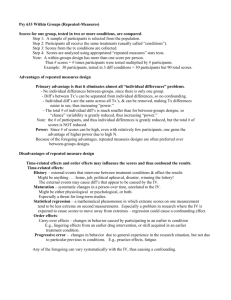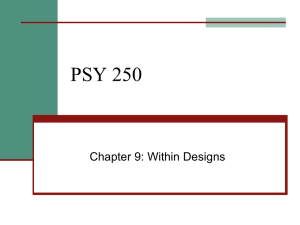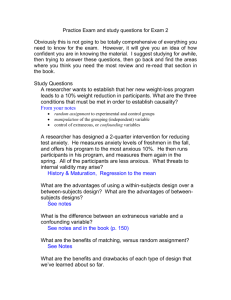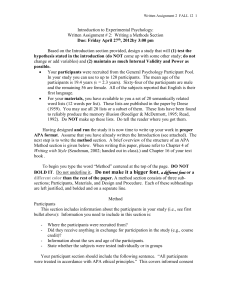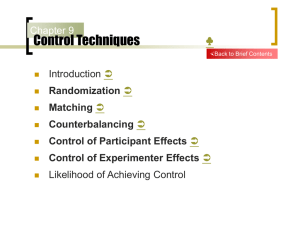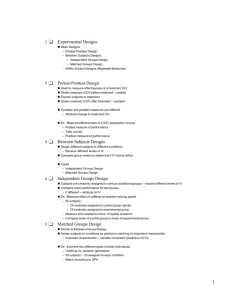Within- Subjects Design
advertisement
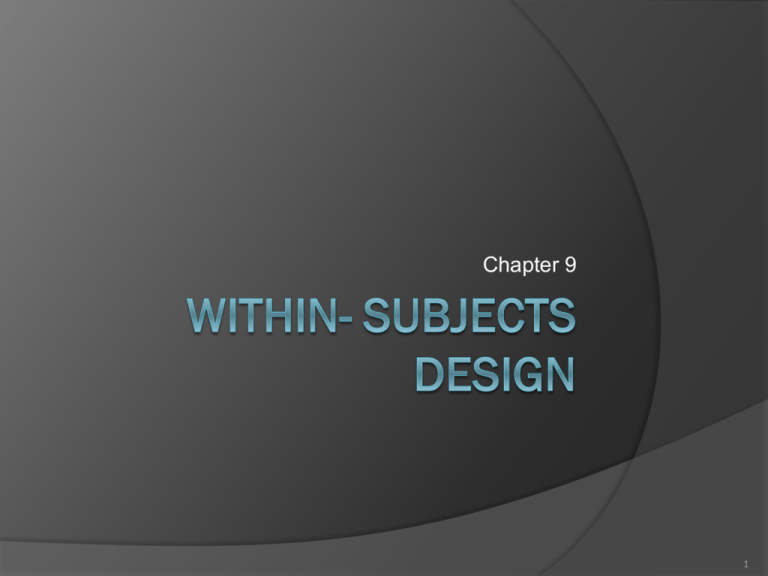
Chapter 9 1 Within & Between designs Within Subjects Students A B C D E Phonics 12 13 15 14 15 Whole Word 15 14 14 15 14 Between Subjects Students Phonics Whole Word A B C D E F G H I J 12 13 15 14 15 15 14 14 15 14 2 /29 repeated- measures A within- subjects experimental design, also known as a repeated- measures experimental design, compares two or more different treatment conditions ( or compares a treatment and a control) by observing or measuring the same group of individuals in all of the treatment conditions being compared. 3 /29 Advantages of Within- Subjects Designs 2 problems are reduced or eliminated in a within- subjects design. • • 1. Group differences 2. High variance 4 /29 Within subjects a within- subjects design is generally more powerful than a between- subjects design; that is, a within- subjects design is more likely to detect a treatment effect than a between- subjects design. 5 /29 Threats to internal validity for within- subjects designs 1- Confounding from environmental variables (room difference, light difference, temperature difference) 6 /29 2- Confounding from timerelated factors. • History. • Maturation.. • Instrumentation. • Testing effects. • Statistical Regression 7 /29 3- participant attrition Another potential problem for the withinsubjects design is participant attrition. 8 /29 4- Order Effects • • • Carryover effect Contrast effect (lighting in the cinema) Progressive error • Practice effect • Fatigue effect • Reduced motivation effect 9 /29 Dealing with time- related threats and order effects 10 /29 1- Controlling Time • if the different treatment conditions are scheduled over a period of months, the chances greatly increase that an outside event ( history, maturation, or change in the measurement instrument) will have an influence on the results. • However if the time between treatments is too short other factors such as fatigue or reduced motivation may change the results 11 /29 2- Switch to a Between- Subjects Design In some situations, order effects are so strong and so obvious that a researcher probably would not even consider using a within- subjects design. For example, a within-subjects design is a poor choice for a study comparing two methods of teaching reading to first- grade children. After the children have been taught with method I, they are permanently changed. 12 /29 3- Counterbalancing The process of matching treatments with respect to time is called counterbalancing. 13 /29 Easy Case Order effects evenly distributed between the treatment conditions. It doesn’t matter which treatment comes first. There is a constant (e.g., d=5 points) change due to order effect 14 /29 No Order effect Pop Music 20 23 25 19 26 17 14 16 Classic Music 27 29 29 26 31 22 20 24 20 26 26-20 =6 Order effect Method A Method B 20 23 25 19 26 17 14 16 32 (27+5) 34 (29+5) 34 (29+5) 31 (26+5) 36 (31+5) 27 (22+5) 25 (20+5) 29 (24+5) 20 31 31-20 =11 Counter Balanced Method A Method B 20 23 25 19 31 (26+5) 22 (17+5) 19(14+5) 21 (16+5) 32 (27+5) 34 (29+5) 34 (29+5) 31 (26+5) 22.5 31 22 20 24 28.5 28.5-22.5 =6 15 /29 Limitations of Counterbalancing 16 /29 Limitation 1 Counterbalancing balances the effect of ordering effect but it doesn’t eliminate it. So both means are inflated 17 /29 Limitation 2 A more serious problem is when counterbalancing adds order effect to some of the individuals but not to all. 18 /29 Limitation 3 When the order effect is not symmetrical • One treatment might produce a larger order effect than the other treatment • (Math & Statistics) • In such situations, the order effects are not symmetrical, and counterbalancing the order of treatments does not balance the order effects. 19 /29 Limitation 4 Number of treatments With only two treatment conditions, complete counterbalancing is easy: There are only two possible sequences. However, as the number of treatments increases, complete counterbalancing becomes more complex. 20 /29 Number of Treatments 21 /29 Partial counter-balancing One solution to this problem is to use what is known as partial counterbalancing. A simple and unbiased procedure for selecting sequences is to construct a Latin square. 22 /29 Latin square 23 /29 Limitation of Latin square The Latin square is not a perfect example of partial counterbalancing because it does not balance every possible sequence of treatment conditions. For example, the first three groups all receive treatment A followed immediately by treatment B. 24 /29 Random order One method for improving the square is to use a random process to rearrange the columns ( for example, a coin toss to decide whether or not each column is moved) 25 /29 Statistical analyses With two treatment conditions, a repeated- measures t test For more than 2 treatments a single-factor ANOVA ( repeated measures) can be used to evaluate the statistical significance of the mean difference. 26 /29 Ordinal & nominal scale If the data are measured on an ordinal scale ( or can be rank ordered), a Wilcoxon test can be used to evaluate significant differences. If the data includes only positive and negative (nominal) effects then we use a sign test. 27 /29 Matched- Subjects Designs In a matched- subjects design, each individual in one group is matched with a participant in each of the other groups. The goal of a matched- subjects design is to duplicate all the advantages of within- and between- subjects designs without the disadvantages of either one. 28 /29 Group Discussion - Ch8-9 Describe some of the problems that can develop if participants from different treatment conditions have an opportunity to talk with each other during the course of the experiment. 29 /29
